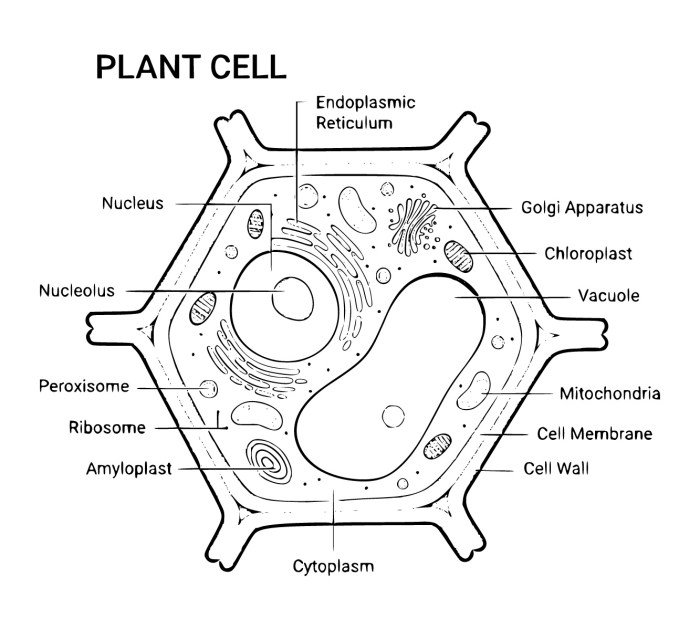Designing Effective Coloring Pages

Plant and animal cell coloring pages – Creating engaging and educational coloring pages requires careful consideration of design elements to cater to different age groups and learning styles. A well-designed coloring page not only provides a fun activity but also reinforces learning about plant and animal cells.
Simple Coloring Page Design for Young Children (Ages 3-5)
This design focuses on basic shapes and large, clearly defined areas for coloring. The page features a simplified representation of both a plant and an animal cell. The animal cell is depicted as a circle with a nucleus (a large, central circle labeled “Nucleus”) and several smaller circles scattered throughout representing other organelles. The plant cell is similarly a circle, but includes a larger, rectangular shape labeled “Chloroplast” within it and a distinct outer rectangle labeled “Cell Wall”.
The colors are limited to a few bright, easily distinguishable shades to avoid overwhelming young children. The overall visual impression is playful and inviting.
Intermediate Coloring Page Design for Elementary School Children (Ages 6-8)
This design increases complexity by adding more detail and organelles. The animal cell includes a labeled nucleus, mitochondria (“Powerhouse of the cell”), and endoplasmic reticulum (“ER”). The plant cell includes the cell wall, chloroplast, nucleus, and a large central vacuole labeled “Vacuole”. The organelles are represented with slightly more realistic shapes and sizes, while still maintaining ease of coloring.
Visual cues, such as using different colors for different organelles, and adding a simple key, help children differentiate between the structures. The design encourages careful observation and labeling.
Complex Coloring Page Design for Older Children and Adults (Ages 9+)
This design presents a highly detailed representation of both plant and animal cells, incorporating a larger number of organelles with more accurate shapes and relative sizes. The animal cell includes labels for the Golgi apparatus, lysosomes, ribosomes, and cytoskeleton, in addition to the organelles in the intermediate design. The plant cell includes a more detailed representation of the chloroplast, showing thylakoids, and depicts plasmodesmata connecting adjacent cells.
A detailed legend is included, providing a brief description of each organelle’s function. The design challenges older children and adults to engage with more intricate details and learn more about cellular structures. Different textures might be suggested for different organelles to further enhance engagement and differentiation.
Educational Activities using Coloring Pages: Plant And Animal Cell Coloring Pages

Coloring pages of plant and animal cells offer a unique and engaging way to learn about cell biology. They can cater to diverse learning styles and age groups, making them a versatile tool for educators. The activities described below demonstrate how coloring pages can be used to foster understanding beyond simple memorization.
Activity 1: Label the Cell Parts
This activity focuses on visual learners and reinforces knowledge of cell structures. Students receive a blank coloring page of either a plant or animal cell, along with a word bank containing the names of the organelles. They color the cell and then label each organelle, matching the names from the word bank to their corresponding locations within the cell. This activity can be adapted for different age groups by adjusting the complexity of the cell diagram and the number of organelles included.
Younger students might focus on larger, more easily identifiable structures, while older students can tackle more intricate details. Assessment involves checking the accuracy of the labeling and the overall neatness of the coloring and labeling.
Activity 2: Cell Structure Comparison, Plant and animal cell coloring pages
This activity targets analytical learners and encourages comparison and contrast skills. Students receive coloring pages of both a plant and animal cell. After coloring, they create a Venn diagram or a comparison chart highlighting the similarities and differences between the two cell types. This activity encourages critical thinking by requiring students to identify key features and analyze their functions.
Adaptation for different age groups involves adjusting the level of detail required in the comparison. Younger students might focus on broad similarities and differences, while older students can delve into the specific functions of different organelles and their evolutionary significance. Assessment involves evaluating the accuracy and completeness of the comparison, and the student’s ability to articulate the reasons for the similarities and differences.
For example, a correct comparison would highlight the presence of a cell wall and chloroplasts in plant cells, absent in animal cells.
Activity 3: Cell Function Story
This activity caters to creative and kinesthetic learners. Students receive a coloring page of a cell (either plant or animal) and are asked to create a short story or narrative describing the daily life and functions of the different organelles within the cell. They can personify the organelles, giving them names and characteristics, and describe how they interact with each other to keep the cell functioning.
This activity encourages imagination and understanding of cell processes in a non-traditional way. Adaptation for different age groups involves adjusting the length and complexity of the story. Younger students might focus on simple descriptions of organelle function, while older students can incorporate more complex biological processes into their narratives. Assessment involves evaluating the creativity of the story, the accuracy of the information presented about cell functions, and the overall understanding demonstrated through the narrative.
For instance, a strong story might describe how the mitochondria provide energy for the cell’s activities, or how the nucleus controls the cell’s functions.
Delve into the microscopic worlds of plant and animal cell coloring pages, where vibrant hues reveal the intricate machinery of life. But before you explore the inner sanctum of the cell, consider a breathtaking autumnal journey with the delightful creatures featured in fall animals coloring pages ; their rich colors mirroring the majestic beauty of the season. Then, armed with newfound inspiration, return to the captivating complexity of plant and animal cells, ready to unlock their hidden wonders.
